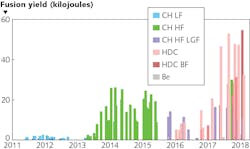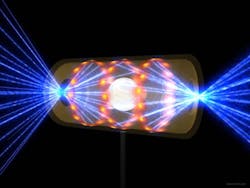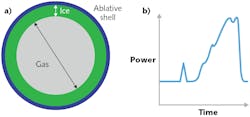Machine Learning: Can machine learning improve computer models enough to ignite internal-confinement fusion?
Laser-fusion researchers have turned to machine-learning techniques to seek the combinations of laser pulse characteristics and target design needed to optimize target implosions for inertial confinement fusion (ICF). This could be an important boost for a program that has struggled to meet the ambitious goal of igniting a fusion plasma, which is a crucial milestone for ICF energy production.
As far back as 1960, computer models predicted that imploding a target containing deuterium and tritium could briefly produce the high temperatures and pressures needed for nuclear fusion. ICF looked attractive both for simulating the physics of thermonuclear weapons and as an alternative to magnetic confinement for fusion energy. The U.S., which had the largest program, developed a series of larger computer models and bigger experimental lasers followed, funded largely by the nuclear weapon program.
The latest and greatest laser built for this effort is the National Ignition Facility (NIF) at the Lawrence Livermore National Laboratory (LLNL; Livermore, CA). It was years behind its original schedule and billions over its original budget when it began operation in 2009, aiming at igniting a fusion plasma by 2012. The laser delivered the 1.8 MJ pulses that computer models had predicted would suffice, but target experimental results fell short of ignition.1
At the end of 2012, NIF shots had reached only 35% of the Lawson criteria, a metric for reaching ignition, says Omar Hurricane, chief scientist for LLNL’s ICF program. He says NIF now has reached 74% of the Lawson criterion. A simpler measure, the neutron yield, has increased by a factor of 21 over the same period. In 2015, LLNL reported that fusion-produced alpha particles were delivering vital heat to the target plasma.
Fusion energy yield also increased greatly over the years (see Fig. 1). In June 2018, LLNL reported breaking a record set in 2014 by pushing the yield of fusion energy to 54 kJ, or 1.9 × 1016 neutrons, more than double the 21 kJ of kinetic energy it took to implode the target.2 That shot used indirect-drive fusion, a process in which the input laser pulse illuminates a so-called “hohlraum” (a cylindrical container with two open ends into which the laser beams pass) that transfers energy to the target (see Fig. 2). Indirect drive illuminates the target more uniformly than directly focusing the laser pulse onto the target, which reduces troublesome plasma instabilities. However, that comes at the cost of energy efficiency, because 1.5 MJ of laser energy goes into heating the hohlraum. The ultimate goal is net energy gain, producing more energy from fusion than is needed to drive the fusion process.Ignition has seemed out of reach for a while. In 2016, a review panel wrote, “Currently, there is no known configuration, specific target design, or approach that will guarantee ignition on the NIF.”3 The U.S. Department of Energy shifted more NIF time to other experiments, and slipped its target for determining prospects for ignition with NIF to fiscal 2020. A review panel commissioned by the National Nuclear Security Administration has already begun visiting labs, and is to deliver its recommendations by the end of fiscal year 2020.4 In 2018, the agency slipped the ignition goal to fiscal 2025.5
Machine learning at OMEGA
Now, at a different location, machine learning has tripled the fusion yield of the simpler direct-drive approach being studied with the 30 kJ OMEGA laser at the University of Rochester (Rochester, NY). Varchas Gopalaswamy and Riccardo Betti of the University of Rochester and colleagues ran simple one-dimensional models hundreds of thousands of times, randomly changing values of pulse shape and target structure for each run. Figure 3 shows two examples. Then, to pick the best designs for a new round of target shots, they compared the simulated results with the actual results of Omega shots using solid deuterium-tritium targets. By linking simulations with experimental results, Gopalaswamy says, they closed in on a machine-designed target that increased neutron yields of the best prior OMEGA shots threefold.6“The parameter space you can explore [in ICF] is immense,” says Betti. They ran their simple tests hundreds of thousands of times, giving them a wealth of data to match against their archive of OMEGA results. That increased the odds that they could improve the design. Scaling their tests to the 1.8 mJ energy of NIF, the Rochester team predicted their new technique could yield designs able to produce 500 kJ of fusion energy—but only when using the pulse to directly drive fusion, rather than using the indirect drive NIF was designed for.
“The Nature paper is a huge step forward,” says Siegfried Glenzer of the SLAC National Laboratory (Menlo Park, CA), who was not involved in that study. He sees the development of laser fusion as a series of single big steps followed by plateaus until the next new insight. Rochester’s machine-learning technique is one such big step, with the potential to circumvent the nonlinearities and instabilities that have plagued complex conventional models. He says the two types of target shots are similar enough for the new technique to improve yields of NIF indirect-drive shots as well as direct-drive shots.
Applying machine learning to NIF
In principle, the Rochester technique could increase fusion yields with NIF, says Hurricane, calling their work “excellent and interesting.” He has a LLNL team using machine learning to improve their experimental results, and urges applying “all promising methods of attack until we have ignition in our hands.” One strength he sees is the ability to point researchers “towards parts of the design parameter space that a human designer may not have considered.” Yet he expects the machine-learning technique “to fail near failure cliffs that exist in the real world, but that the simulations just don’t capture.”
Another concern in scaling the technique to NIF is that machine learning requires large volumes of input data. OMEGA can fire many shots in a single day and has accumulated large archives over many years of operation. In contrast, NIF typically needs about five days to set up and perform a single shot for ignition research. Glenzer says that at such a low shot rate, it would be hard to build a large-enough data bank for machine learning. He suggests that other alternatives might be possible, including firing test shots with LCLS-II, the upgraded version of SLAC’s Linear Coherent Light Source (Menlo Park, CA), an x-ray laser source scheduled for first light in the fall of 2020.7
LLNL has its own course plotted for the next few years. The central pressure produced by NIF target shots now far exceeds the central pressure in the sun, Hurricane says. Fusion yields now correlate strongly with energy in the central hot spot, as predicted by theory. His group is scaling up the surface area of targets to absorb more energy from the hohlraum while maintaining velocity and symmetry of the target implosions. The NIF team is trying to understand and overcome anomalies in beam-line behavior. LLNL teams also are working to resolve anomalies observed in target behavior, including nonuniform areal density, low fuel compression, hot spot movement to the side, and capsule defects.
“More energy makes the general ICF problem easier to solve, since more energy relaxes requirements on precision,” says Hurricane. But he says trying to start planning a new fusion laser “would be beyond foolish...until we clearly understand all the problems that need to be faced and resolved and clearly determine what is really required.”
The computer understands
That blend of hope and caution comes from years of experience that scaling inertial fusion tends to reveal new problems. The prediction of a dramatic increase in fusion yield is “fraught with peril, because there are considerable uncertainties in how the physics and instabilities scale over such a large energy range,” wrote Mark Herrmann, NIF director at LLNL, in a Nature commentary. “It is humbling for scientists dedicated to understanding such complex systems to recognize how much they don’t understand.” He closed his article by quoting an observation that Eugene Wigner made many years ago in a different context: “It is nice to know that the computer understands the problem. But I would like to understand it, too.”
A National Nuclear Security Administration (NNSA) review panel is studying the whole inertial-fusion program, including indirect drive, direct drive, and a magnetic pulsed-power approach pursued at Sandia National Laboratories (Albuquerque, NM). The goal, says Glenzer, a panel member, is to plan an upgrade of NIF to higher pulse energy and power that could be used in new experiments that would either reach ignition or take researchers to the point where they could understand how to ignite a fusion plasma.
REFERENCES
1. J. Hecht, “Will NIF number laser fusion among its accomplishments?” Laser Focus World (Feb. 2013); http://bit.ly/HechtJan20Ref1.2. S. Le Pape et al., Phys. Rev. Lett., 120, 24, 245003 (Jun. 2018); http://bit.ly/HechtJan20Ref2.
3. National Nuclear Security Administration, “2015 Review of the Inertial Confinement Fusion and High Energy Density Science Portfolio: Vol. 1,” p. ii (May 2016).
4. Department of Energy, FY2020 Congressional Budget Request, National Nuclear Security Administration, DOE/CF-0150, 1, 183–186 (Mar. 2019).
5. National Nuclear Security Administration, “Fiscal Year 2019, Stockpile Stewardship and Management Plan – Biennial Plan Summary,” Report to Congress, 4–17 (Oct. 2018).
6. V. Gopalaswamy et al., Nature, 565, 581–586 (Jan. 31, 2019), http://bit.ly/HechtJan20Ref6.
7. See http://bit.ly/HechtJan20Ref7.
8. M. C. Herrmann, Nature, 565, 577–578 (Jan. 31, 2019).
About the Author
Jeff Hecht
Contributing Editor
Jeff Hecht is a regular contributing editor to Laser Focus World and has been covering the laser industry for 35 years. A prolific book author, Jeff's published works include “Understanding Fiber Optics,” “Understanding Lasers,” “The Laser Guidebook,” and “Beam Weapons: The Next Arms Race.” He also has written books on the histories of lasers and fiber optics, including “City of Light: The Story of Fiber Optics,” and “Beam: The Race to Make the Laser.” Find out more at jeffhecht.com.



